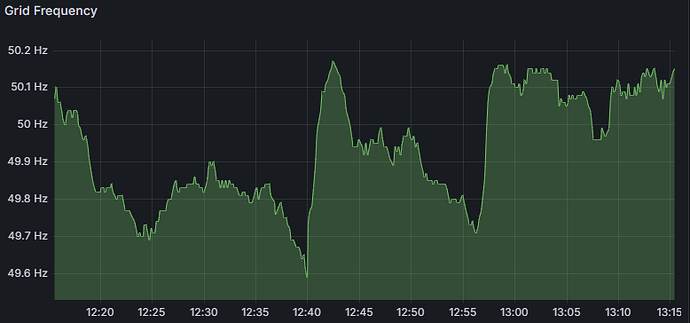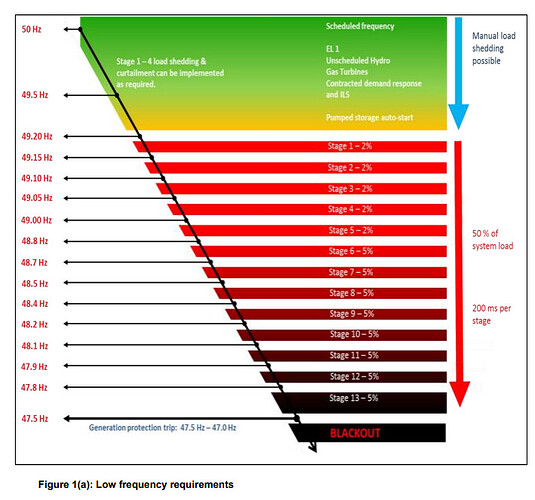Think about it…over time. It might not be directly cash in hand, but is money that stimulates economic growth
There was this guy in Mossel Bay yonks ago when solar was in it’s infancy, that measured Eskom Hz and predicted from that problems to be expected. He had this huge genny that would kick in on Hz to protect all his ‘mad scientist projects’ ![]()
Was busy setting up the reporting on a site and happened to look at the grid frequency. This is just the last hour. It looks pretty bad.
Grid Code: https://www.nersa.org.za/wp-content/uploads/2022/02/SAGC-System-Ops-Version-10.1_January-2022.pdf
Interesting to see when Hz goes to low…
It’s like trying to play the stock market ![]()
How is this managed in a load shedding scenario. Generator puts X MWh into grid, off taker expects that X MWh. As long as the grid is up it’s easy: The source of the MWh that the off taker takes doesn’t matter as long as the generator put in the stipulated amount of renewable energy.
But if there’s load shedding? Now the X MWh goes into the grid but who gets to take that off?
Do they have point to point connections between generator and off taker?
Remember, CoCT already skips a LS level or two most times on their grid.
This wheeling is probably on their grid, not Eskom.
So the more wheeling that can take place, the less dependent CoCT is on Eskom, the more LS levels can be skipped - in the end.
Sunny daytime that is, when businesses operate.
Weather allowing.
“Eskom … is there ANY chance? In CPT there is” comes to mind. ![]()
I still think there’s a technical issue here. One generator is in Brackenfell as is their customer. Now when Brackenfell gets shed what happens? They can’t let the generator’s power feed the suburb (there won’t be enough for a start), so it seems to me that there must be a point to point connection, of some clever switches that come into play.
Or a clause in the contract that says sorry, no supply when there is load shedding.
Eskom is going to follow do what!?
Remember, CoCT was there first using “aerial surveilance” to find unregistered SSEG systems.
Then we have: Conlog and geysers … let the games begin
And then this: R440bn private transmission gamble that could finally end load shedding
With this happening right here in Cpt … CoCT, 2400 panels up at Atlantis … ok!
Welcome back dude.
Eskom, look and learn …
I’ll just put this here … as the heading starts with ESKOM …
So will CoCt also follow suit, if Eskom drops the professional engineer sign off ???
That is in the local CoCT regulations … we’ll see if anything comes from that.
I saw this. I don’t think it’s necessarily a money saver, but it may mean that the pool of people who can do the certification gets bigger. An electrician’s time is still valuable and there’s no reason why they shouldn’t charge for it.
We have to have a Installation or Master Electrician do the install, or just connect a solar system (to cut costs), to give a CoC.
What does not make too much sense:
- the “Eskom” engineering requirements for signoff and what engineers need to charge to cover their backs.
- the forced bi-directional meter.
- the “red tape” Eskom thinks they can enforce.
Those three are many thousands I suspect for non-CoCT people.
I accepted the engineering signoff with a smile because at the time not all Installation/ Master Electricians where 100% clued up on solar installs.
Not even today all are “jacked” enough. Base that on experiences gained (yet again) last year.
Hence the engineering signoff, I see it as checking the electricians work.
Let me way in here as this is very much close to home.
There are a few misunderstandings overall from both OUTA and Afriforum.
Let’s use the example of statement smade: “Only City of Cape Town allows exports”
“An SSEG not exporting is not connected to the grid”
These two are blatantly false.
The problem here is a few factors:
- Energy Regulation Act enforces all distributors to register Embedded Generators on their network.
- Distribution license conditions enforces that distributors must maintain a safe and complaint grid (compliance to grid codes).
- SANS or any other applied standard under the Electrical Installations Regulations covers only the work done from Point of Control to Point of Consumption (you house DB to plugs).
So, now OUTA and Afriforum want Eskom to stop complying with the Electricity Regulation Act.
They disagree with how Eskom wants to keep their network safe and compliant and ultimately they are relying on the wrong regulations and standards to back their case.
The main responsibilities of the ECSA registered professional is not the double check the electrician’s work, but to ensure the system is set up to comply with SA Grid codes, network safety and utility compliance.
Saying that, any Professional would be negligent if they do not also ensure the client is safe, thus I ensure to do a double check on the safety of any system.
While I have signed off more than a 1000 systems by now, I have seldom passed many of them on the first go.
How much power can you really take out of 100,000 home batteries? Let’s say that these are all 10kWh banks with a 5kW inverter, that gives us 500,000kW for two hours. Not even a megawatt for two hours? Seems small change at utility level…

